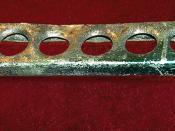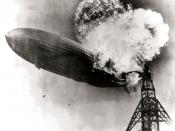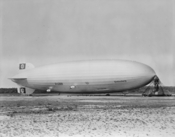Was the Hindenburg disaster a result of sabotage? Did lightning hit the zeppelin? Or was one of the most devastating accidents in history nothing but a cunningly planned insurance fraud?
Over 60 years ago, airships were the queens of the skies. In the early 1900s, Count Ferdinand von Zeppelin, a brilliant German count, took keen interest in balloon flights and was devoted to the design and construction of airships. At first, he had many difficulties and setbacks but soon his airships were able to accommodate passengers as well. This vehicle that was lighter than air, will later be known as a zeppelin.
Zeppelins and blimps were very different. For example, blimps did not have an internal frame; whereas the zeppelin had a "skeleton" which supported the gas bags.
During World War I, German zeppelins were used to bomb London from the air. Because of this, they earned the name of "monsters of the purple twilight."
Although their bombs damaged English cities, the zeppelins would often fly off course, miss their targets or be shot down by British planes. By the end of the war, so many German zeppelins have been lost that these high altitude warships were declared useless as war machines. To boost spirit, the Germans even made a song for it. The Hindenburg, also known as LZ-129, was one of Nazi Germany's finest airships and was the first airship to provide air service across the Atlantic. It is actually the largest and most luxurious zeppelin ever built. It represented the greatness of the Third Reich and its leader, Hitler.
Construction began in 1931 but the Zeppelin Company ran out of money for the project and stopped. Hitler became the Chancellor of Germany in 1933 and realized that a giant airship could be used to spread the propaganda...



Hindenburg
This was a really interesting essay. I learnt a lot. The only, extremely minor criticism involes; 'Rumors spread and World War II started. It's obvious that the Hindenburg was, is, and will remain the most tragic occurrence of the 20th century.' This is a little extreme and not in keeping with the carefulness shown by the remainder of the essay.
3 out of 3 people found this comment useful.